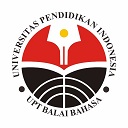Wakamono Kotoba in “Tokyo Revengers” by Ken Wakui: A Study of Morphology and Semantics
Abstract
Japanese slang or wakamono kotoba grows rapidly in Japanese and frequently found in Japanese media, such as in manga and anime. The differencebetween wakamono kotoba and standardized Japanese language forms and meanings becomes a problem in understanding the meanings of wakamono kotoba, especially for Japanese language learners. As an attempt to solve this problem, this study aims to analyze the forms and meaning of Japanese slang words or wakamono kotoba. The data were collected from Japanese comic titled Tokyo Revengers by Ken Wakui, and analyzed using the identity method and distribution techniques. The data of wakamono kotoba found then analyzed based on word formation theory by Tsujimura (1996),and to analyze the meaning of wakamono kotoba, contextual meaning theory by Pateda (2001) was used. The results showed that wakamono kotobacan be divided into five morphological forms including affixation, compound, reduplication, clipping, and borrowing. In terms of meaning, there arewakamono kotoba which still express the original meaning, while a certain number of wakamono kotoba have changed its’ meanings from their original meanings.
Keywords
Full Text:
PDFReferences
Andayani, L. (2019). Struktur pembentukan Wakamono kotoba dalam anime Gekkan Shoujo Nozaki-kun episode 1-12 karya Tsubaki Izumi [The structure of the formation of Wakamono kotoba in the anime Gekkan Shoujo Nozaki-kun episodes 1-12 by Tsubaki Izumi]. Japanology, 7(2), 269-283. (Accessed from http://journal.unair.ac.id/JPLG on September 2021)
Booij, G. (2007). The Grammar of Words: An Introduction to Morphology. New York: Oxford University Press.
Chaer, A. (2003). Linguistik Umum [General Linguistics]. Jakarta: PT. Rineka Cipta.
Chaer, A., & Leoni, A. (2010). Sosiolingustik [Sociolinguistic]. Jakarta: PT. Rineka Cipta.
Chotimah, U. N., & Sabiq, A. H. A. (2021). An analysis on contextual meaning of selected songs in Rex Orange County’s album “Pony” and its pedagogical implication. JELTL (Journal of English Language Teaching and Linguistics), 6(2), 425-438. https://dx.doi.org/10.21462/jeltl.v6i2.560
Gee, J. P., Allen, A. R., & Clinton, K. (2001). Language, class, and identity: Teenagers fashioning themselves through language. Linguistics and Education, 12(2), 175-194.
Hidayat, N. N. (2021). Analysis of wakamono kotoba (Slang words) as the Interjections in LINE chat conversation. Presented in the Fifth International Conference on Language, Literature, Culture, and Education (ICOLLITE 2021). https://dx.doi.org/10.2991/assehr.k.211119.074
Julianita, R. (2016). Wakamono kotoba dalam manga Air Gear volume 1-5 karya Oh! Great [Wakamono kotoba in Oh!'s Air Gear manga volumes 1-5. Great]. Humanis: Journal of Arts and Humanities, 15(1), 104-110. (Accessed from https://ojs.unud.ac.id/index.php/sastra/article/view/19786 in September 2021)
Kridalaksana, H. (2009). Kamus Linguistik [Linguistic Dictionary]. Jakarta: PT Gramedia Pustaka.
Liu, Y., & Seki, Y. (2021, December). Joint Model Using Character and Word Embeddings for Detecting Internet Slang Words. In International Conference on Asian Digital Libraries (pp. 18-33). Springer, Cham.
Masakazu, I., Yukako, O., Hiroshi, S., & Naoko, M. (2003). Shin Sedai no Gengogaku [New Dictionary of New Generation]. Tokyo: Kuroshio.
Matsumoto, K., Akita, K., Keranmu, X., Yoshida, M., & Kita, K. (2014). Extraction Japanese slang from weblog data based on script type and stroke count, Procedia Computer Science, 35, 464-473. https://doi.org/10.1016/j.procs.2014.08.127
Matsumoto, K., Ren, F., Matsuoka, M., Yoshida, M., & Kita, K. (2019). Slang feature extraction by analysing topic change on social media. CAAI Transactions on Intelligence Technology, 4(1), 64-71.
Nihongo Zokugo Jiten. (2021). Garake ‘Garake’ o imi [The meaning of ‘Garake’] (accessed from http://zokugo-dict.com/06ka/garakee.htm in September 2021)
Nihongo Zokugo Jiten. (2021). Yankee ‘Yankii’ no Imi [The meaning of ‘Yankii’] (accessed from http://zokugo-dict.com/36ya/yankii.htm in September 2021)
Pateda, M. (2001). Semantik Leksikal [Lexical Semantic]. Jakarta: Rineka Cipta.
Pineda, R. A. (2020). 4th annual kodansha manga awards’ nominees announced. (Accessed from https://www.animenewsnetwork.com/news/2020-04-02/44th-annual-kodansha-manga-awards-nominees-announced/.158217)
Robertson, W. C. (2020). Scripting Japan: Orthography, variation, and the creation of meaning in written Japanese. Routledge.
Sudipa, M. H. D. (2021). Gairaigo dalam novel Tensei Shitara Slime Datta Ken karya Fuse: Kajian morfologi dan semantic [Gairaigo in Fuse’s novel Tensei Shitara Slime Datta Ken: A study of morphology and semantics]. Janaru Saja: Jurnal Program Studi Sastra Jepang, 10(1), 21-32. DOI 10.34010/JS.V10I1.4733
Sudaryanto, S. (2015). Metode dan Aneka Teknik Analisis Bahasa [Methods and Techniques of Language Analysis]. Yogyakarta: Sanata Dharma
Tsujimura, N. (1996). An Introduction to Japanese Linguistics. Oxford: Blackwell Publishers Ltd.
Wakui, K. (2017a). Tokyo Revengers Volume 1. Tokyo: Kodansha.
Wakui, K. (2017b). Tokyo Revengers Volume 2. Tokyo: Kodansha.
Weblio. (2021). Wanpan no imi – kaisetsu [The meaning and analysis of ‘Wanpan’]. (Accessed from https://www.weblio.jp/content/ワンパン in September 2021)
DOI: https://doi.org/10.17509/japanedu.v7i1.38996
Refbacks
Copyright (c) 2022 JAPANEDU: Jurnal Pendidikan dan Pengajaran Bahasa Jepang

This work is licensed under a Creative Commons Attribution-ShareAlike 4.0 International License.
 Published by:
Published by: Department of Japanese Language Education, Faculty of Language and Literature Education
Universitas Pendidikan Indonesia
 Online ISSN: Online ISSN:2528-5548 |

JAPANEDU: Jurnal Pendidikan dan Pengajaran Bahasa Jepang (e-ISSN:2528-5548) lisenced under a Creative Commons Attribution-ShareAlike 4.0 Internasional (CC BY-SA 4.0)

